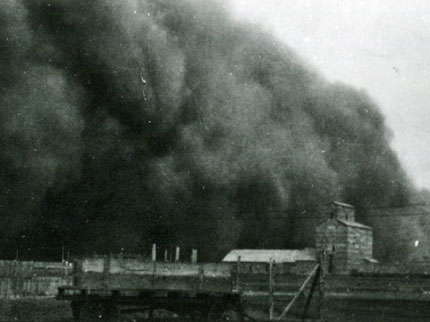
Agricultural News
"Black Sunday" Convinced Congress to Establish the Soil Conservation Service at USDA
Thu, 16 Apr 2015 06:41:43 CDT
 April 14, 1935 saw sunny skies turn pitch black- but that darkness in southwest Kansas, the Oklahoma and Texas Panhandles and western Oklahoma was the foundation for a brighter future as forward thinking leaders called on Congress to respond- and provide farmers, ranchers and landowners with the conservation resources needed to stop enormous amounts of dirt moving through the air..
April 14, 1935 saw sunny skies turn pitch black- but that darkness in southwest Kansas, the Oklahoma and Texas Panhandles and western Oklahoma was the foundation for a brighter future as forward thinking leaders called on Congress to respond- and provide farmers, ranchers and landowners with the conservation resources needed to stop enormous amounts of dirt moving through the air..
This week marked the 80th Anniversary of "Black Sunday" (April 14, 1935) when blowing dust blasted the High Plains. Conservation groups came together to commemorate the anniversary of "Black Sunday" at the Oklahoma State Capitol.
Oklahoma State Conservationist Gary O'Neill said the Dust Bowl was attributed to the dry weather and to the poor soil conservation techniques used at the time. He said the region had seen 15 - 20 years of prolonged drought, a lot of ground was broken out of prairie grassland into farmland without proper conservation practices. In growing wheat in one of worst droughts this country had ever seen, he said there wasn't adequate ground cover and the bare soil was exposed to high winds and dry conditions, which led to massive dust erosion.
"Black Sunday" was the start of a conservation movement. Congress created the Soil Conservation Service (SCS) as a permanent agency in the U.S. Department of Agriculture just months after dirt was seen in Washington that came from Oklahoma- carried by the dust storm that slammed the Panhandle on April 14, 1935. Later came Conservation Districts and the partnership with private land owners.
Now 80 years later, Oklahoma continues to deal with massive drought, but the state has not seen the massive dust storms like the 1930's. O'Neill attributes that to farmers learning new techniques of farming, new equipment and the adoption of new technology. In an interview with Radio Oklahoma Network Farm Director Ron Hays, O'Neill shared how other challenges remain today. Click or tap on the LISTENBAR below to hear the full interview.
O'Neill said today there is still soil-water erosion and dust erosion. He believes there are some opportunities for agriculture to continue to improve in the wheat belt of the country. He said a lot has been learned through soil health by tilling less, planting cover crops as well as increasing plant diversity. On grazing lands, he said ranchers need to make sure they are leaving enough grass cover to ensure roots are providing the soil protection needed.
O'Neill said there are a lot resources available to landowners today with tools, programs, and technical assistance to help farmers and ranchers. Today landowners have access to the Conservation Reserve Program and Conservation Stewardship Program through the Natural Resource Conservation Service. Soil Health has also become an important part of conservation through minimal tillage to keep the crop armored for protection against erosion while feeding the microorganisms that live in the soil.
"I think that's a big thing, as we're trying to understand and now realize how important that is, to being a soil that actually functions healthy, does the carbon cycling that we need, does the nutrient cycling that's important," O'Neill said. "You know understanding that is a big part of our soil health initiative that we're working on right now."
To learn more about April 14, 1935 and how Black Sunday is a date to remember- click here.
WebReadyTM Powered by WireReady® NSI
Top Agricultural News
More Headlines...




















